Archive for September, 2011
Bringing in the Grapes – Part III
I received a note today from Kirsty Harmon, winemaker and general manager at Blenheim Vineyards, and I thought I would draw from it to add a little bit to my last post. Kirsty was kind enough to take time out from this most difficult harvest to talk with our class, even though we had barely harvested as much, between the entire group, as a single member of a field crew would have picked in, oh, maybe 15 minutes? Remember, I did say in Part II
that we spent a lot of time staring at the vines, wanting to be sure that we didn’t add bad fruit to the lugs or leave good fruit on the ground.
In any event, we were working on half a section of Viognier that day. Kirsty had told us that they picked the first half a week earlier, due to advanced ripening at the top of the hill and indications that sour rot was starting to set in. Since it was clear that rain was on the way, Blenheim picked the first section which had ripened early, and let the rest hang on in the hope that it would continue to gain sugar and flavor.
The two types of rots that appeared on the grapes in the second section – Botrytis and sour rot – both make grapes mushy (both leak juice with a vinegary odor), and so by the time they would have made it back to the sorting table, they would have leaked all over he good fruit.
“Field sorting is labor intensive, but worthwhile,” Kirsty said. “I would say that many
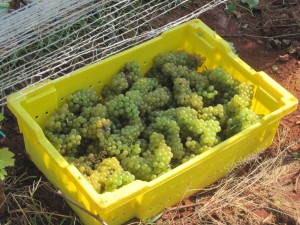
- We weren't very fast, but the fruit we added to the lugs sure looked good! Can't wait to taast the wine. 2011 Viognier.
wineries do take the time to do it though. Lots of wineries pick into bins rather than lugs, and not all wineries have the ability to sort when the fruit is picked into the half ton bins.”
You can see from the pictures in my last post how small lugs are. They are meant to bring grapes back to the crush pad or sorting table in good condition, without the weight of too many clusters at the top crushing those on the bottom.
Blenhein has almost completed its harvest. It has a small amount of Cab Franc remaining to be picked at the vineyard, and a few varieties in the Shenandoah Valley vineyards that it sources grapes from. You can bet that every winemaker and every vineyard manager will be glad to have all their fruit off the vine and into the fermentation tanks. It’s been that kind of year.
“This vintage has been the most challenging one of my career in Virginia,” said Kirsty. I think that almost every vineyard in the Commonwealth – and probably a good many in California as well – would agree.
Bringing in the Grapes – Part II
Since we don’t have grapes of our own to harvest this year, we did the next best thing, and took a class at Piedmont Virginia Community College on “Harvesting and Basic Analysis of the Must,” taught by the incomparable Gabriele Rausse.
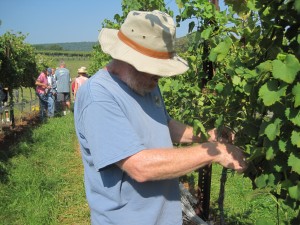
- Each grape is precious – I don’t want to send bad fruit to the crush pad, but I don’t want to waste good fruit either.
After a brief classroom lecture, we moved on to Blenheim Vineyards, where we helped (help being a relative term) pick one section of Viognier grapes. I went into this assuming that picking grapes might be the one thing about viticulture that would be so straightforward, so foolproof – SO SIMPLE! – that we could just do it, without staring at the vines, paralyzed with fear, before asking for help.
Well, no such luck.
For this particular section of the vineyard, Blenheim was “sorting in the vineyard,” which is to say, we were dropping grapes that had succumbed to disease or sour rot, or were otherwise not suitable for pressing. Most often, you bring the grapes in and sort at the crushpad, separating out the fruit that doesn’t belong in the must, and getting rid of MOG – matter other than grapes. (You’d be surprised at how many spiders make their way to the crushpad. )
This has been an exceptionally difficult year for Virginia vineyards, and Blenheim didn’t want to take a chance on letting bad fruit infect the good back at the winery. So, in addition to sorting at the crushpad, Blenheim left bad fruit on the ground in the vineyard. Continue Reading–>
Planning for the Spring Planting
Well, we still haven’t come to terms on the vines, but we’re confident we’ll get there, so we’re turning part of our attention to the work necessary to prepare the vineyard for planting. And believe me, there’s lots to do.
First, the decisions. I say first, because the thinking part comes before the physical labor part. And I’ve learned just enough about vineyard management to know that the thinking part is going to be a lot easier than the physical labor part of this enterprise.
But that’s not to say that the thinking part is easy. Nope, not on your life, Bud. There’s a number of decisions to be made. Such as, which way to orient the rows.
The consensus in the viticultural world appears to be that rows should run as close to north to south as possible, so that the sun falls full force on the eastern side of the canopy in the morning and the western side in the afternoon. There are secondary concerns as well. For example, if your vineyard is on a significant slope, the rows should run perpendicular to the slope, which minimizes erosion. Or, if a north-south rows would be too short to be practical – which is to say, if your vineyard is some kind of long, very narrow rectangle – you can orient in a different direction.
However, secondary considerations always lose to the prime directive, which is that rows should run north to south.
In our case, we are somewhat handicapped because the trees surrounding our hobby vineyard limit sun in the morning. Morning is a critical time. Moisture accumulates during the night, and it’s important that the canopy dry as quickly as possible in the morning. That’s why an eastern aspect – a slope, or even flat land, that opens to the east – is so desirable.
Other forces of nature, wind in particular, also dry out vines, but while the sun is reliable in that it appears every morning, wind can’t be counted on. On the mornings that we’ve woken to a steady breeze, we’ve noticed that everything dries quickly. (We probably noticed that years and years ago, but since it didn’t matter to us until now, we didn’t take much note of it.) So, despite the generally untrustworthy nature of wind, we are now trying to figure out if it tends to blow in a particular direction in our little valley. If so, then perhaps it would pay to forget the conventional wisdom and go with a different approach.
There’s more, of course. I’ll be continuing this discussion for some time to come. Thank God we’re still on the thinking part.
In Search of a Few Good Vines
Now that we know what kinds of grapes we want to grow, it’s time to get down to the serious business of ordering vines and getting ready for spring planting. (Actually, this whole process has been serious business, but since the selection of grape varieties mostly involved visiting wineries and tasting wine, this part of the effort is serious in a somewhat different way.)
We began with some research on what clones have done well in Virginia. When you order vitis vinifera wines (which encompasses the European-style grapes most people are most familiar with, from Chardonnay to Cabernet Sauvignon), you’re making two decisions for each variety – the type of rootstock to use and the clone that will be grafted onto it. At a minimum, it’s important that rootstocks be resistant to such pests as phylloxera, the root louse that all but destroyed European vineyards in the 19thcentury, and nematodes, but we’re also looking for roots that will inhibit excessive growth, withstand cold winters, and work well in our soil, which is clay and loam. Long story short, we’ve pretty much decided to go with a root stock known as 101-14, the same root stock on the Cab Franc vines we’ve already planted in both the Fairfax and Nelson County vineyards.
Clones are more interesting, and they took a bit more time to figure out. Keep in mind that grape vines reproduce asexually. Cuttings from a Cab Franc are used to produce more Cab Franc
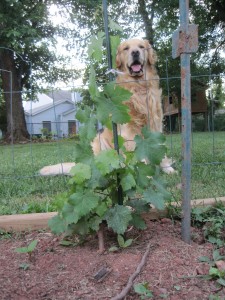
Here's a Cab Franc vine in the Fairfax vineyard (with Phoenix the Vineyard Dog standing guard) The clone is FPS 4, grafted onto 101-14 rootstock. The picture was shot a few months after planting.
vines, and it is presumed that the clone will exhibit the same qualities and characteristics as the vine it was taken from. But variations occur, and if a new vine exhibits differences that are deemed to be desirable, it may be characterized as a new clone and propagated more widely. So there isn’t just a single Viognier or a lone Cab Franc. There are a number of different Cab Francs, each classified as a separate clone, and each exhibiting different qualities, not just in the way they grow, but in the quality of the wine they produce.
So the choice of clones was very important to us. We relied heavily on Tony Wolf’s indispensible book,Wine Grape Production in Eastern North America, and came up with the following oddly-named clones (actually, all clones are oddly named; they sound a bit like the parts in an erector set) : For Cab Franc: ENTAV 214, 327, or 623 (whichever one we can get); for Petit Manseng: ENTAV 573; Petit Verdot, ENTAV 400, and Viognier: ENTAV 642. I mentioned Merlot in my last post, but we’ve pretty much decided that’s a clone too far for this year.
You can see that the clones we are most interested in all have the word ENTAV in their name. ENTAV (which stands for, Etablissement National Technique pour l’Amelioration de la Viticulture, or National Educational Association for Viticultural Improvement) are grapes of French origin, and sold in the United States through licensed nurseries. (By contrast, the clones we purchased early this year, referenced in the caption above, are FPS, which stands for Foundation Plant Services, the UC-Davis department that produces, tests, maintains and distributes premium foundation-level virus & disease-tested plant materials for use by California nurseries.)
We called one of the nurseries a few days ago, assuming that when we told them we planned to order a whopping 125 vines that they would fall all over themselves to help us, perhaps even offering to fly us out to California to get a look at the nursery. (You know I’m kidding, right? I would guess that their average order is measured in multiples of a thousand vines.) Our actual assumption is that we’d be able to get someone on the phone who could talk to us for a couple of minutes and then take our order and credit card number.
The nursery was Sunridge, which seems to be one of the very best in California, and the woman who worked with us could not have been friendlier or more helpful. Unfortunately, they didn’t have most of what we wanted. It turns out that they didn’t develop most of what we wanted “on spec” this year.
“On spec” seems to mean roughly the same thing in the grape vine nursery business as it does in the housing industry, where developers either build to order for a buyer who puts money down in advance, or build on spec in the hopes that buyers will show up with cash in hand. Whatever the case, they had the Viognier clones, but nothing else among our favorites.
Okay, that was a surprise. We had just assumed that everything on the web site would be immediately available and that all we had to do was call and ask for what we wanted. Now we are wondering if we will have to settle for clones that aren’t exactly what we want or wait another year to get clones of our dreams. Given that it takes a minimum of three years before the vines begin producing grapes, and a year or more after that before the wine is ready to drink, you only have so many chances in a single lifetime to get it right. And in our case, we only have so much land to devote to this enterprise. Putting off the planting for a year is not an option.
My wife, the Vineyard Goddess, sprang into action, and promptly identified a number of nurseries that distribute the varieties of grapes that we’re looking for. Great news! The bad news, however, was that only a handful sold the ENTAV clones we’re looking for.
We knew that there are only a limited number of ENTAV-approved nurseries in the United States, but we didn’t know how limited that number was. It turns out that only four nurseries in the U.S. are licensed to sell ENTAV clones, and two of them appear to have merged. Of the remaining two, one doesn’t have a web site, which is making it difficult to contact them, and the fourth has been a bit slow in getting back to us.
We think there might be other options, including Mercier California. According to the National Grape Registry, which is hosted by UC-Davis, Mercier has a presence in California. However, Mercier’s web site is tout en francias, and we are wondering if their ENTAV vines are shipped from France. Not that I care where they are shipped from. However, I do care about shipping costs. A friend who spent most of his life working vineyards in Bordeaux highly recommended Mercier, so we are hopeful that this is a viable option.
Okay, apparently purchasing vines isn’t as simple as logging into Amazon and selecting one-day shipping. But most of the things in life that are worthwhile require some extra work. And if anything warrants extra labor, it’s good wine. We’ll keep at it until we get it right. And with luck, we’ll be ordering those vines next week!

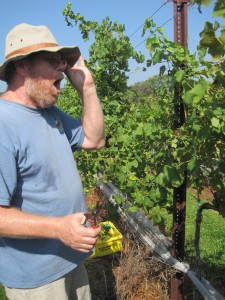

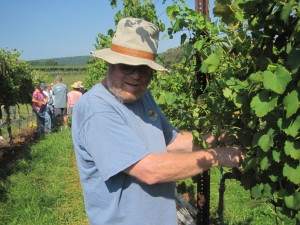
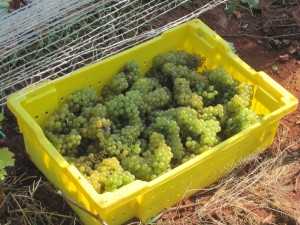
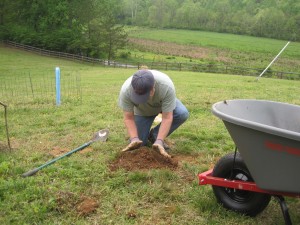


Recent Comments